Abstract
1. Acoustic rhinometry is a relatively new method for objectively assessing nasal airway patency. In this paper we compare acoustic rhinometry with active posterior rhinomanometry. 2. Twenty normal healthy volunteers underwent nasal challenge with either histamine or bradykinin, 100 micrograms to 1000 micrograms, and responses were assessed by acoustic rhinometry. A further 20 subjects received identical nasal challenges and responses were assessed by active posterior rhinomanometry. 3. On a subsequent occasion, the subjects challenged previously with histamine, were given the selective H1-receptor antagonist, cetirizine, 10 mg orally, 3 h before repeat nasal challenge with histamine, 100-1000 micrograms. Again, responses were assessed by active posterior rhinomanometry and acoustic rhinometry. 4. The acoustic reflection measurements and the nasal airway resistance measurements showed comparable, significant dose-related changes in nasal patency to both histamine and bradykinin. Pretreatment with cetirizine blocked the histamine-induced change in nasal patency as measured by both methods. 5. We conclude that acoustic rhinometry has a number of advantages over posterior rhinomanometry. It is quick to perform, requires minimal subject co-operation and gives a reliable objective, measurement of dose-related changes in nasal airway patency before and after pharmacological treatment.
Full text
PDF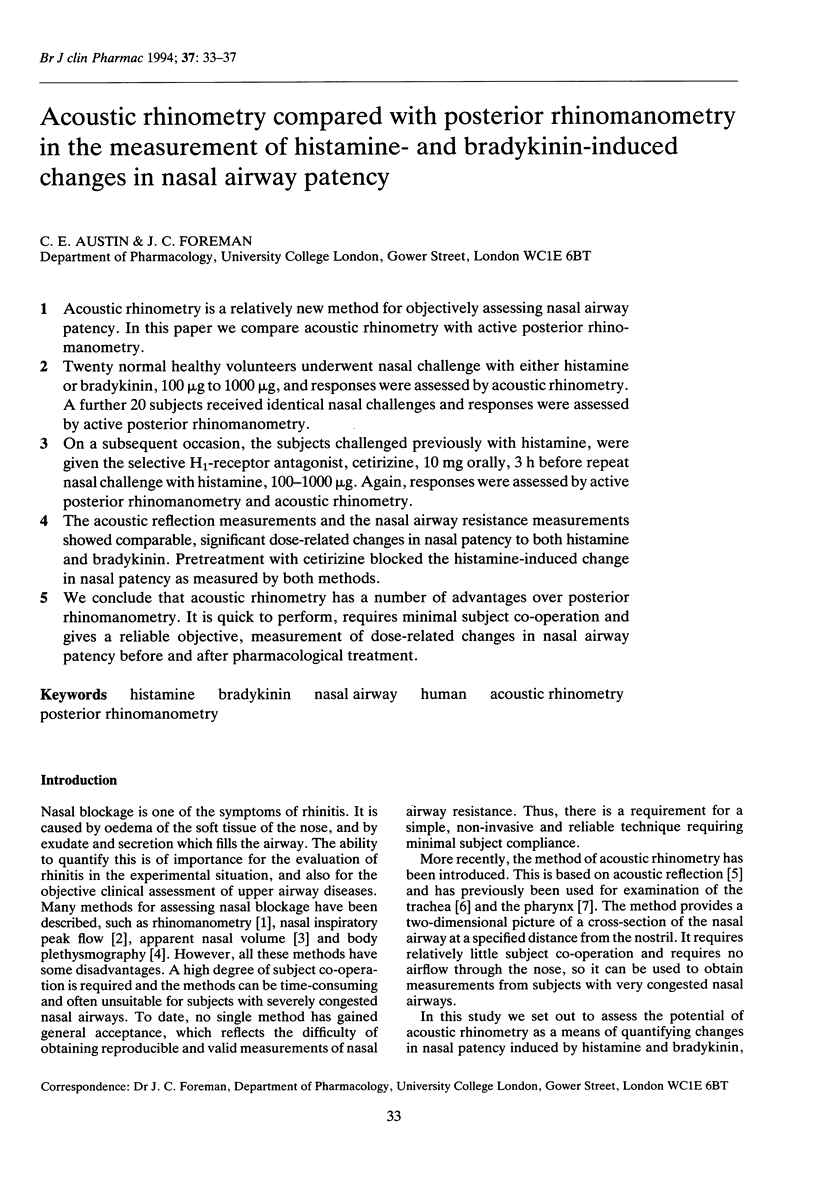
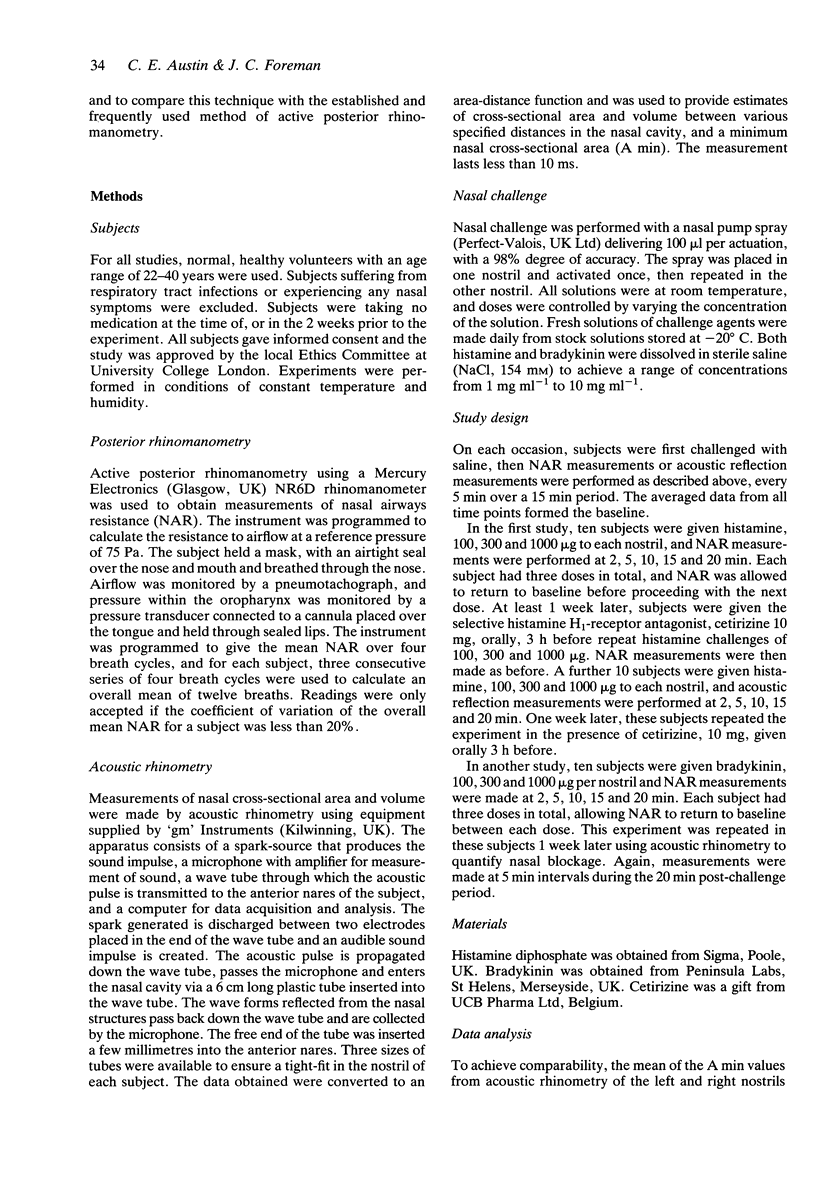
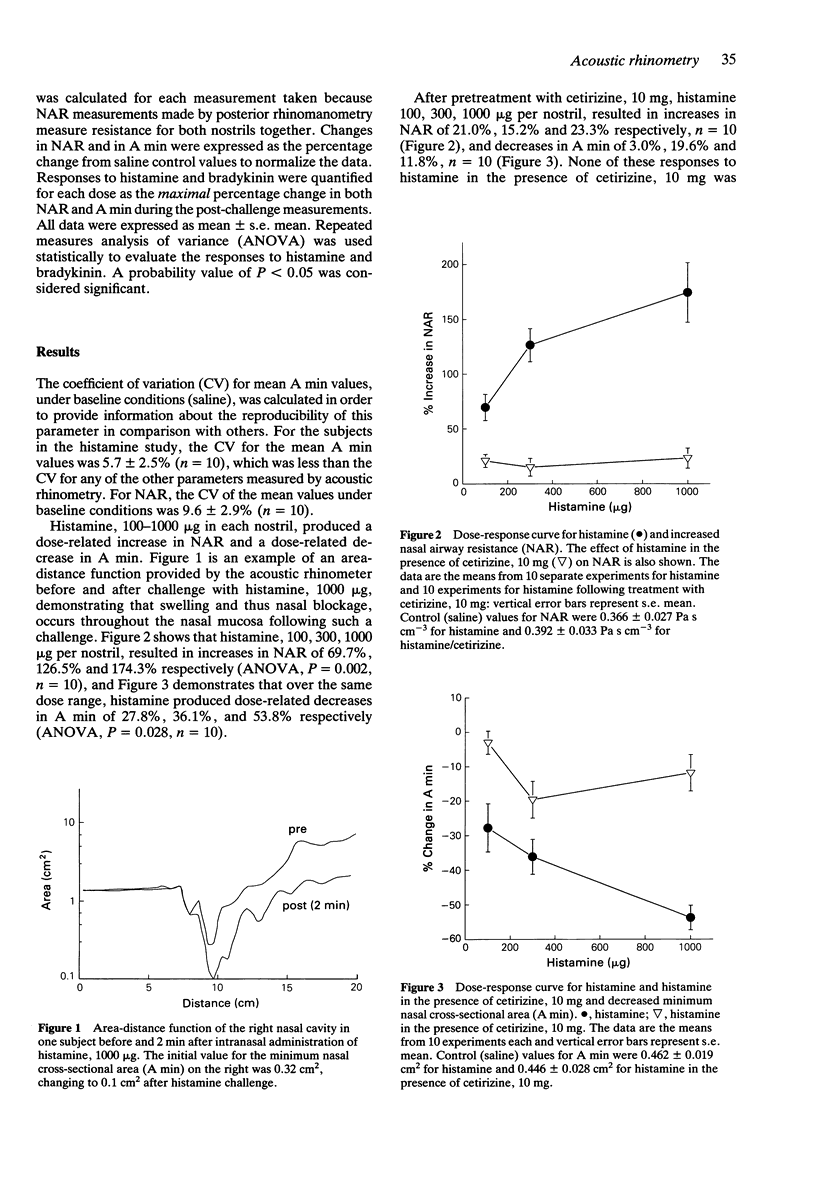
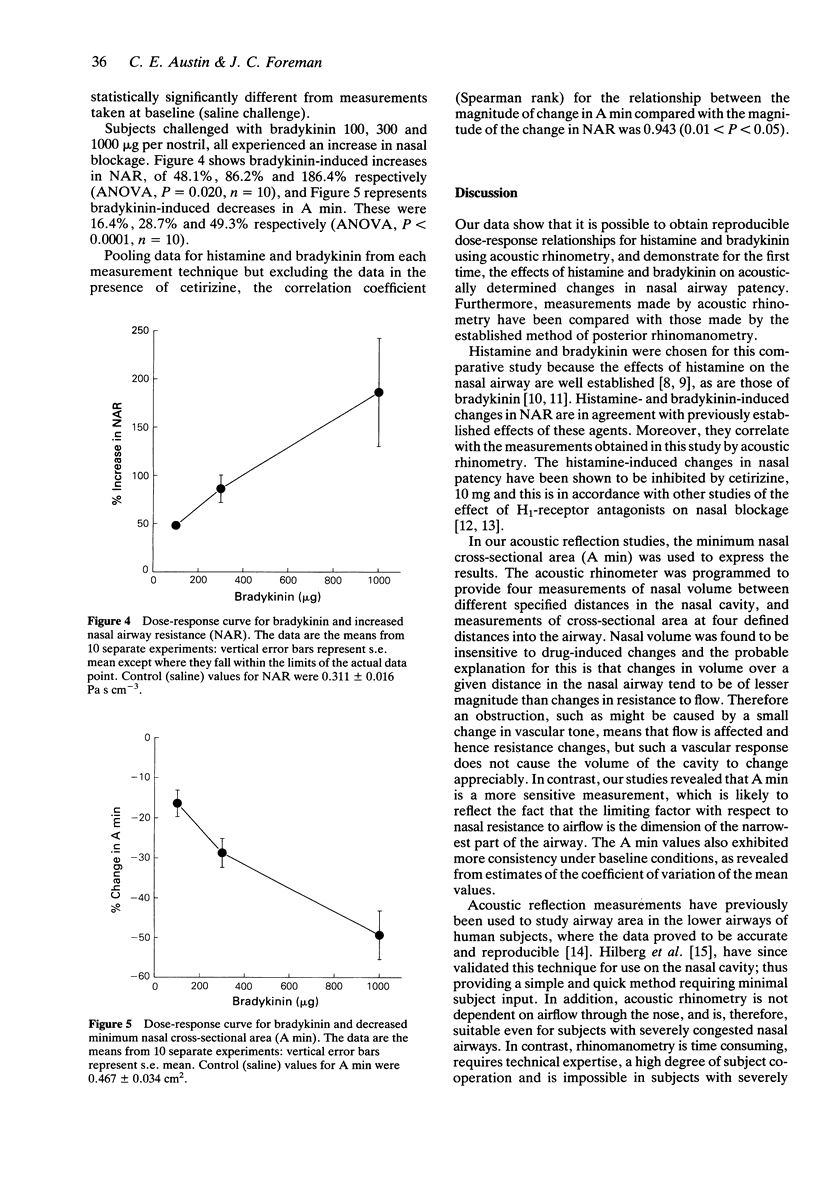
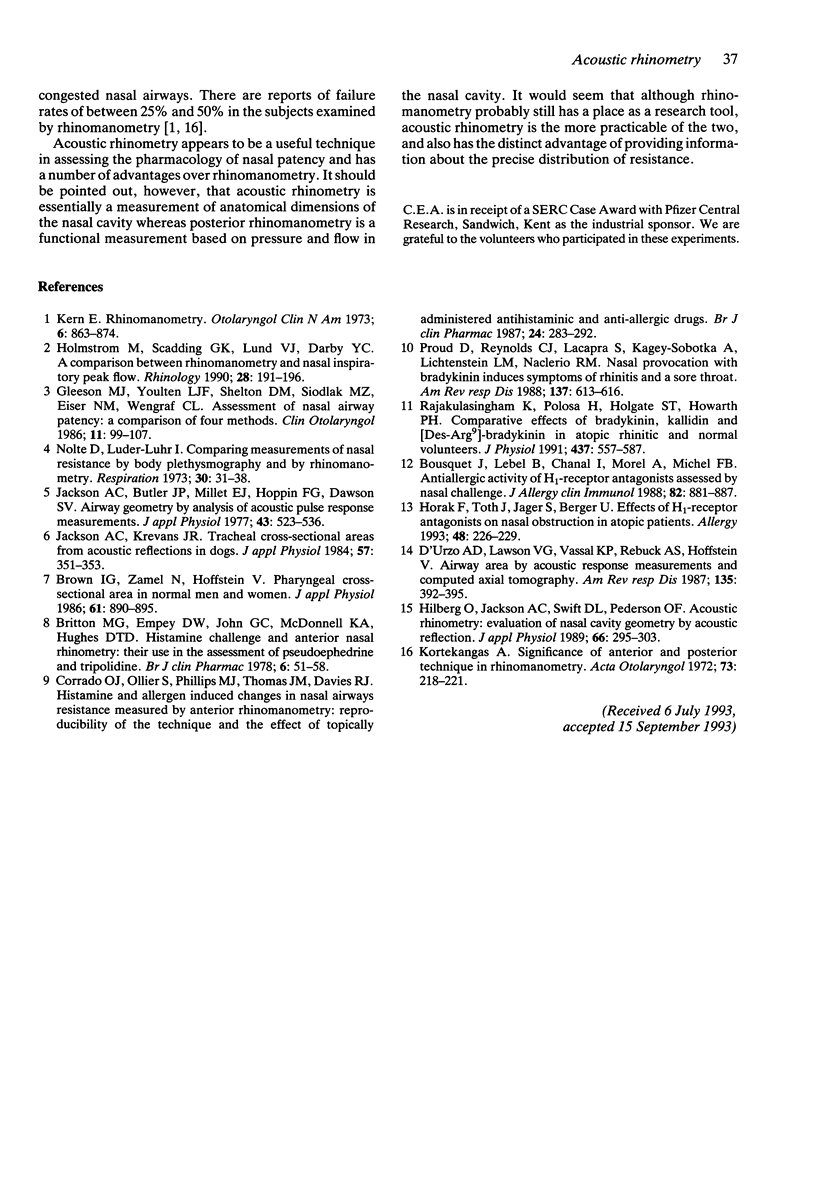
Selected References
These references are in PubMed. This may not be the complete list of references from this article.
- Bousquet J., Lebel B., Chanal I., Morel A., Michel F. B. Antiallergic activity of H1-receptor antagonists assessed by nasal challenge. J Allergy Clin Immunol. 1988 Nov;82(5 Pt 1):881–887. doi: 10.1016/0091-6749(88)90094-2. [DOI] [PubMed] [Google Scholar]
- Britton M. G., Empey D. W., John G. C., McDonnell K. A., Hughes D. T. Histamine challenge and anterior nasal rhinometry: their use in the assessment of pseudoephedrine and triprolidine as nasal decongestants in subjects with hayfever. Br J Clin Pharmacol. 1978 Jul;6(1):51–58. doi: 10.1111/j.1365-2125.1978.tb01681.x. [DOI] [PMC free article] [PubMed] [Google Scholar]
- Brown I. G., Zamel N., Hoffstein V. Pharyngeal cross-sectional area in normal men and women. J Appl Physiol (1985) 1986 Sep;61(3):890–895. doi: 10.1152/jappl.1986.61.3.890. [DOI] [PubMed] [Google Scholar]
- Corrado O. J., Ollier S., Phillips M. J., Thomas J. M., Davies R. J. Histamine and allergen induced changes in nasal airways resistance measured by anterior rhinomanometry: reproducibility of the technique and the effect of topically administered antihistaminic and anti-allergic drugs. Br J Clin Pharmacol. 1987 Sep;24(3):283–292. doi: 10.1111/j.1365-2125.1987.tb03171.x. [DOI] [PMC free article] [PubMed] [Google Scholar]
- D'Urzo A. D., Lawson V. G., Vassal K. P., Rebuck A. S., Slutsky A. S., Hoffstein V. Airway area by acoustic response measurements and computerized tomography. Am Rev Respir Dis. 1987 Feb;135(2):392–395. doi: 10.1164/arrd.1987.135.2.392. [DOI] [PubMed] [Google Scholar]
- Gleeson M. J., Youlten L. J., Shelton D. M., Siodlak M. Z., Eiser N. M., Wengraf C. L. Assessment of nasal airway patency: a comparison of four methods. Clin Otolaryngol Allied Sci. 1986 Apr;11(2):99–107. doi: 10.1111/j.1365-2273.1986.tb00114.x. [DOI] [PubMed] [Google Scholar]
- Hilberg O., Jackson A. C., Swift D. L., Pedersen O. F. Acoustic rhinometry: evaluation of nasal cavity geometry by acoustic reflection. J Appl Physiol (1985) 1989 Jan;66(1):295–303. doi: 10.1152/jappl.1989.66.1.295. [DOI] [PubMed] [Google Scholar]
- Holmström M., Scadding G. K., Lund V. J., Darby Y. C. Assessment of nasal obstruction. A comparison between rhinomanometry and nasal inspiratory peak flow. Rhinology. 1990 Sep;28(3):191–196. [PubMed] [Google Scholar]
- Horak F., Toth J., Jäger S., Berger U. Effects of H1-receptor antagonists on nasal obstruction in atopic patients. Allergy. 1993 May;48(4):226–229. doi: 10.1111/j.1398-9995.1993.tb00720.x. [DOI] [PubMed] [Google Scholar]
- Jackson A. C., Butler J. P., Millet E. J., Hoppin F. G., Jr, Dawson S. V. Airway geometry by analysis of acoustic pulse response measurements. J Appl Physiol Respir Environ Exerc Physiol. 1977 Sep;43(3):523–536. doi: 10.1152/jappl.1977.43.3.523. [DOI] [PubMed] [Google Scholar]
- Jackson A. C., Krevans J. R., Jr Tracheal cross-sectional areas from acoustic reflections in dogs. J Appl Physiol Respir Environ Exerc Physiol. 1984 Aug;57(2):351–353. doi: 10.1152/jappl.1984.57.2.351. [DOI] [PubMed] [Google Scholar]
- Kern E. B. Rhinomanometry. Otolaryngol Clin North Am. 1973 Oct;6(3):863–874. [PubMed] [Google Scholar]
- Kortekangas A. E. Significance of anterior and posterior technique in rhinomanometry. Acta Otolaryngol. 1972 Feb-Mar;73(2):218–221. doi: 10.3109/00016487209138933. [DOI] [PubMed] [Google Scholar]
- Nolte D., Lüder-Lühr I. Comparing measurements of nasal resistance by body plethysmography and by rhinomanometry. Respiration. 1973;30(1):31–38. doi: 10.1159/000192973. [DOI] [PubMed] [Google Scholar]
- Proud D., Reynolds C. J., Lacapra S., Kagey-Sobotka A., Lichtenstein L. M., Naclerio R. M. Nasal provocation with bradykinin induces symptoms of rhinitis and a sore throat. Am Rev Respir Dis. 1988 Mar;137(3):613–616. doi: 10.1164/ajrccm/137.3.613. [DOI] [PubMed] [Google Scholar]
- Rajakulasingam K., Polosa R., Holgate S. T., Howarth P. H. Comparative nasal effects of bradykinin, kallidin and [Des-Arg9]-bradykinin in atopic rhinitic and normal volunteers. J Physiol. 1991 Jun;437:577–587. doi: 10.1113/jphysiol.1991.sp018612. [DOI] [PMC free article] [PubMed] [Google Scholar]


